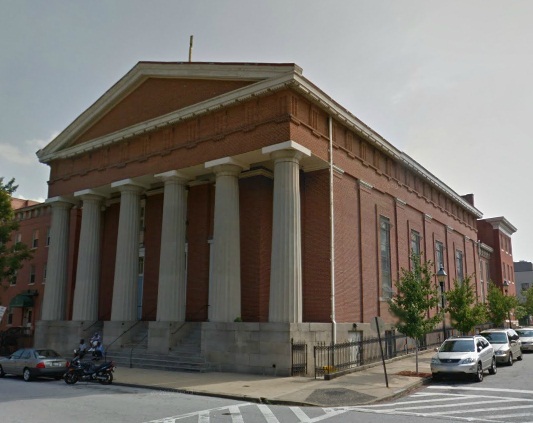Lost City: Baltimore Town

There are two stories behind the creation of John Moale’s drawing of Baltimore Town. One version is that sometime in the late eighteenth century, Moale (ca. 1731-1798) sat down and sketched from memory the Baltimore of his youth. The other account has the amateur artist sitting on the future Federal Hill and sketching the town from life in 1752.
Baltimore Town in 1752, by John Moale, MdHS museum collection, 1845.1.1.
Sitting down in a field or on a city bench, pulling out a sketch pad, and drawing a building or cityscape is today a lost practice, largely left to artists. In an era when you can access a digital map of the entire world, and then zoom in on practically any building on earth, a sketch of a house, or even a printed map of city, may seem almost primitive. The watercolor to the right, which could easily be mistaken for a child’s drawing, is actually the earliest existing depiction of Baltimore when it was still just a tiny backwater town. Merchant and land developer John Moale’s unfinished sketch is a document of 1752 Baltimore, then known as Baltimore Town, that although rendered in “shocking disregard…of the laws of perspective,” gives a sense of the architecture of eighteenth century Baltimore now almost entirely lost. While there are surviving examples of houses from the mid to late 1700s still standing in the city (and photographic examples of many now gone), none of the structures depicted in Moale’s “original and homely draft” remain.(1)
In 1752, Baltimore Town was a “small, straggling village,” of roughly 200 inhabitants who lived, worshiped, and drank in 25 houses, one church, two taverns, and a brewery.(2) The drawing captures the young town just prior to a boom period marking the beginning of 200 years of uninterrupted population growth that wouldn’t come to an end until 1950. In the 1750s the town’s commercial and residential possibilities began to attract a diverse group of immigrants. German and Scotch-Irish businessmen from Pennsylvania, French-Acadians exiled from Nova Scotia in 1755, and other immigrant groups traveled to the waterfront community in the hopes of starting a new life. By 1760 there were over 1200 inhabitants. Fourteen years later, on the eve of the Revolution, the population consisted of nearly 6,000 people living in some 560 residences.
Most of these dwellings were simple wooden structures, between one and two stories in height. The most common homes found in eighteenth century Baltimore were three or four bay-wide structures with gambrel roofs and dormers. Only four of the 25 houses pictured in John Moale’s original sketch were brick; in 1741, Irish immigrant Edwin Fottrell, using bricks imported from England, began construction on the first. The Fottrell house – the largest residence in 1752 Baltimore Town – was erected at what is today the northwest corner of Fayette and Calvert Streets.(3) Fottrell returned to his homeland sometime before 1755, leaving the residence unfinished and in a state of disrepair.
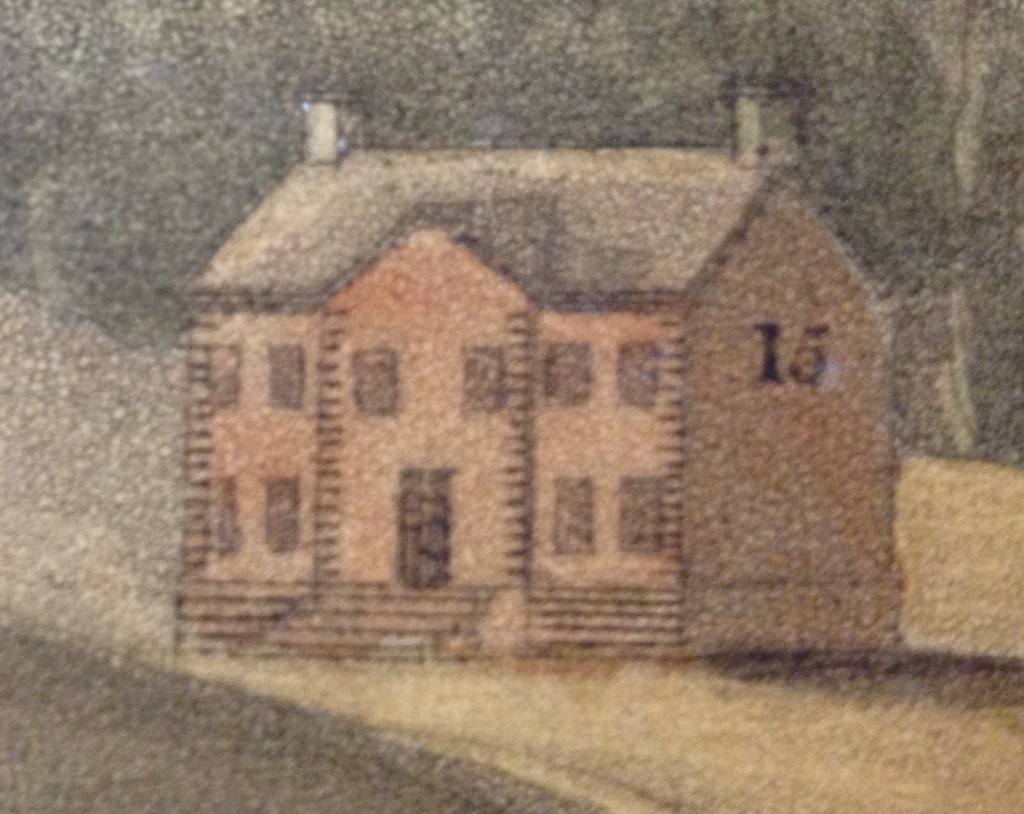
Edwin Fottrell house. Baltimore in 1752, 1817 engraving by William Strickland based on a 1752 sketch by John Moale, MdHS, H16.
The deserted home lay vacant for only a short time as it was soon occupied by a group of newly arrived French-Acadian refugees whose ship had appeared unexpectedly in the harbor. The refugees – part of a larger group of 900 that had arrived in Annapolis following their expulsion from Nova Scotia by British authorities – were soon being called on by Reverend John Ashton, the resident Catholic priest of Carroll Manor. Ashton visited Baltimore Town once a month to provide church services for the few Catholics living there. The Reverend and his congregation, consisting of some 40 members – including a few of the Acadians – took for their place of worship one of the lower rooms of the Fottrell house; one of their first tasks consisted of “expelling the hogs which had habitually nested there.”(4)
From these squalid beginnings emerged Baltimore’s first Catholic Church. In 1770 the congregation began construction on St. Peter’s Church, at the corner of Saratoga and Charles Streets. Although the original building was torn down in 1841, a new church was built two years later that still stands at the corner of Hollins and Poppleton Street in West Baltimore. Edward Fottrell’s house, on the other hand, had a much shorter life span. In 1780 the State of Maryland seized the residence and property, which was then in the possession of Fottrell’s heirs, divided up the land into six lots and sold them off at auction.
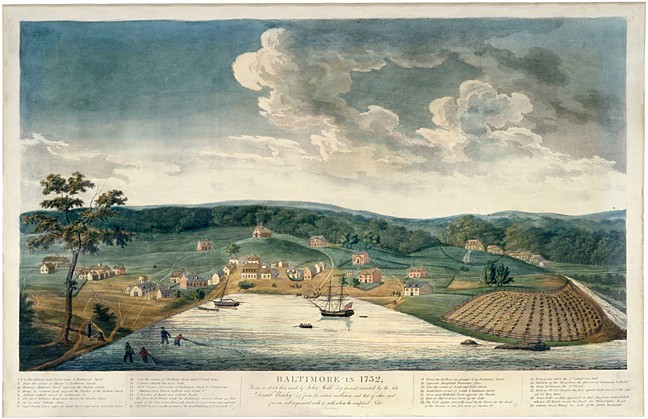
John Moale’s sketch of Baltimore Town provided the basis for a number of prints in the first half of the nineteenth century that proved to be very popular. Moale provided no identifications of the structures that he sketched out – the later reproductions have filled in many of the details left out by the amateur artist. Probably the most widely known as well as the most artistically rendered is an 1817 engraving by architect William Strickland. Some notable additions are the two ships visible in the harbor. The larger vessel is the “Phillip and Charles,” owned by William Rogers who also operated of one of the town’s two taverns. Docked on the left side of the harbor is the Sloop “Baltimore,” built in 1746 and owned by Captain Darby Lux, a two-time commissioner of Baltimore Town. The ship was the first Baltimore owned vessel to be sailed from the port. Lux’s house on Light Street is also identified in the print. The main thoroughfare, visible in the center of the engraving, is Calvert Street. Baltimore in 1752, 1817 engraving by William Strickland based on a 1752 sketch by John Moale, MdHS, H16.
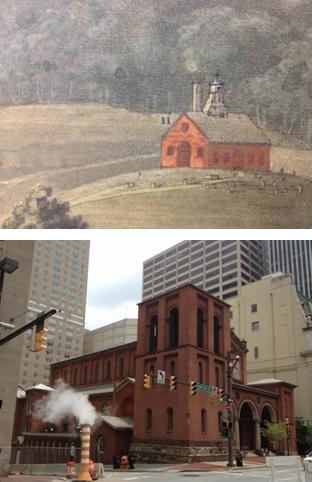
The first and fourth St. Paul’s Protestant Episcopal Church.
(top) The first, built 1739, razed in 1786; Baltimore in 1752, 1817 engraving by William Strickland based on a 1752 sketch by John Moale, MdHS, H16, (detail)
(bottom) The fourth, built in 1854, 233 N. Charles Street, June 2013.
The most prominent structure in Moales’ original sketch, although it appears unfinished, is St. Paul’s Protestant Episcopal Church, Baltimore’s first church of any denomination. Completed in 1739, it was built atop Saratoga Street Hill, the highest point in town. By 1780, the building had become too small to accommodate its rapidly growing congregation, and a new church was built on another section of the large parcel of land bound by Lexington, Saratoga, Charles and St. Paul Streets, purchased by the church when the town was first established in 1729. The original church was put to use as a school until being demolished in 1786.
One feature of the early town that does not appear in either Moale’s sketch or the later reproductions was a wooden fence erected around the town in 1750. According to historian Thomas Scharf, the fence was built to protect the town from hostile tribes of Native Americans. Many sources have repeated this tale, although it appears the townsfolk had a far more mundane reason for erecting the fence that encircled the town “as completely as the walls enclosed a medieval fortress.”(5) It was instead devised as a barrier against the herds of swine, flocks of sheep, and gaggles of geese that roamed freely throughout the town. The hogs did serve some purpose, acting as an early sanitation department, as well as providing a source of food for the poorer members of the community. But these benefits were apparently soon outweighed by their penchant for destroying property, creating ruts in the roads, endangering children and causing general mayhem.
The fence however had a brief existence – residents soon began removing sections of it for firewood. One of the persons accused of pilfering timber was Thomas Chase, the rector of St. Paul’s Church. By November of 1752 most of the fence was gone. Whether John Moale intended to add the fence to his unfinished drawing or whether he sought to keep the image of the dilapidated enclosure from the historical record when he sat down to put pen to paper will probably never be known.
In 1796, Baltimore Town – which in 1773 had merged with Jones Town and Fell’s Point – incorporated to form the City of Baltimore. Only a handful of the buildings that existed prior to the merger of the three neighboring communities survived into the late nineteenth century. The last building visible in John Moale’s sketch to fall by the wayside was apparently Kaminsky’s inn, located at 106-110 Mercer Street, at the northwest corner of Mercer and Grant Streets. An 1885 Baltimore Sun article described the tavern as being:
“built in 1750 of wood, two stories and an attic, with dormer windows. The first story was plastered outside and the upper part weather-boarded. A lone flight of stairs from the outside led up to the second story. The building presented the appearance of an old-fashioned German hostelry. It was the grand hotel of the city. Washington, Lafayette and other revolutionary heroes stopped there.”(6)
Baltimore Town’s last remaining building finally met its demise in the early 1870s when it was razed to make way for three iron-front buildings at 101-105 East Redwood Street. These buildings were in turn destroyed some 30 years later when the Great Fire of 1904 swept through downtown Baltimore. A dozen years passed before another edifice, the Sun Life Insurance Company Building, was erected.(7)
In 2000, the site of one of Baltimore’s first two inns made a return to its roots when the Sun Life Building and its companion on the block – the former headquarters of the Merchant and Miners Transportation Company – were demolished to make way for a Residence Inn Marriott. While it lacks the charms of its predecessor, with laundry dangling from its windows (see photo below), it does make up for it in girth, rooming capacity, and general unattractiveness. (Damon Talbot)
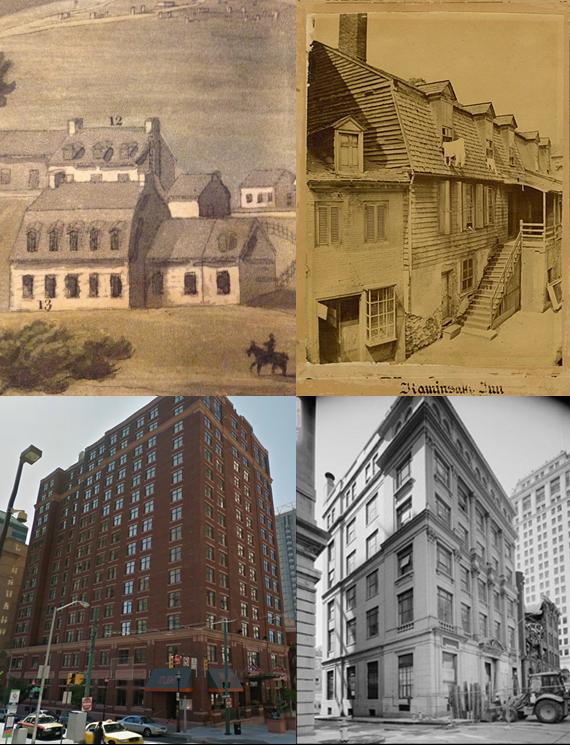
Progression of a city block.
(Top left) Kaminsky’s Inn. Baltimore in 1752, 1817 engraving by William Strickland based on a 1752 sketch by John Moale, MdHS, H16, (detail)
(Top right) Kaminsky’s Inn, ca 1875, MdHS, CC 2821. The Tavern was originally two stories; a third story was added at some point in the nineteenth century to adjust to alterations in the street level.
(Bottom right) Sun Life Insurance Building, 109 East Redwood Street, about to be demolished, ca 2000; the building next to it is the partially demolished former Headquarters of the Merchant and Miners Company.(photograph not from MdHS’s collection)
(Bottom left) Marriott Residence Inn, 17 Light Street, June 2013.
Footnotes:
(1) Scharf, J. Thomas, The Chronicles of Baltimore: Being a Complete History of “Baltimore Town” and Baltimore City (Baltimore: Turnbull Brothers, 1874), 48; Mayer, Brantz, Baltimore: Past and present with biographical sketches of its most prominent men (Baltimore: Richardson and Bennett: 1871)
(2) Scharf, Thomas J., History of Baltimore City and County (Baltimore: Regional Publishing Company, 1971), 58.
(3) Baltimore in 1752, 1817 engraving by William Strickland based on a 1752 sketch by John Moale, MdHS, H16.
(4) Scharf, J. Thomas, The Chronicles of Baltimore, 66.
(5) Stockett, Letitia, Baltimore: A Not Too Serious History (Baltimore: Grace Gore Norman, 1936), 45.
(6) “A Leaf from the Past,” The Baltimore Sun, December 5, 1885
(7) The Sun Life Insurance Company building was designed by Louis Levi, the first Jewish member of the Baltimore chapter of the American Institute of Architects.
Sources and further reading:
Beirne, Francis F., St. Paul’s Parish, Baltimore: A Chronicle of the MotherChurch (Baltimore: Horn-Shafer Company, 1967)
Clark, Dennis Rankin, Baltimore, 1729-1829: The Genesis of a Community (Washington D.C., 1976)
Griffith, Thomas W., Annals of Baltimore (Baltimore: Printed by William Wooddy, 1824)
Gunts, Edward “Residents may rise at Redwood and Light,” The Baltimore Sun, November 29, 2004.
Gunts, Edward “Turning Point for Downtown,” The Baltimore Sun, August 13, 2000.
Hayward, Mary Ellen & Frank R. Shivers Jr., ed., The Architecture of Baltimore: An Illustrated History (Baltimore: JohnsHopkinsUniversity Press, 2004)
Jones, Carleton, Lost Baltimore: A Portfolio of Vanished Buildings (Baltimore: Maclay & Associates., 1982)
Kelly, Jacques, “Redwood Street preservation move grows”, The Baltimore Sun, September 30, 2000.
Kelly, Jacques, The Voice of this Calling: St. Paul’s Parish – Baltimore, Maryland, 1692-1992 (Baltimore: The Vestry of St. Paul’s Parish, 1993)
“A Leaf from the Past,” The Baltimore Sun, December 5, 1885
MarylandState Archives, Archives of Maryland (Biographical Series) John Moale
The Passano-O’Neill Files: Light Street (7-11); Mercer Street (106-110); Charles Street (231 North); Calvert Street (100-102 North)
Rice, Laura, Maryland History in Prints, 1743-1900 (Baltimore: The Press at the Maryland Historical Society, 2002)
Scharf, J. Thomas, The Chronicles of Baltimore: Being a Complete History of “Baltimore Town” and Baltimore City (Baltimore: Turnbull Brothers, 1874)
Scharf, J. Thomas, History of Baltimore City and County (Philadelphia: Louis H. Everts, 1881)
Stockett, Letitia, Baltimore: A Not Too Serious History (Baltimore: Grace Gore Norman, 1936)


